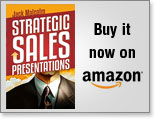I’ve been working on a sales coaching module for the past few weeks, so an article in Sunday’s New York Times business section about Google’s Project Oxygen caught my eye this morning.
Google analyzed thousands of performance reviews and other inputs to figure out what separated their top managers from the rest, and came up with eight practices.
Anyone who has worked as a manager for even a little while probably knows most of these, but the study was noteworthy because it provided hard data to what is usually a product of common sense and general wisdom. Even more importantly, it ranked them.
In Part 1 of this article, we saw that closed questions can be very useful at the opening stages of the call because they are easy to answer. That quality is ironically what makes them least useful during the closing stages of the call.
Again, this seems to challenge long-standing sales lore. As salespeople, we’re told to ask for the close and to lock in agreements when the time is ripe. A typical example of a closed question would be:
“Do you see the value in speeding up the process?”
The idea is that if the customer says yes, (and you’re sure she will based on the conversation to that point), store you don’t let them off the hook—you continue the positive momentum by asking a series of questions calculated to elicit yeses until you finally ask for the proverbial signature on the dotted line.
What’s wrong with this approach?
Whenever I ask salespeople in my classes which type of questions are most effective, open-ended or closed, the overwhelming majority select open. The reasons given are that open questions are best at getting the customer talking and for finding out unexpected information. After all, if you’re in a solution sale, it’s critical to find out as much as possible about the customer’s business and current situation in order to uncover pain points. They do like closed questions, however, when they are trying to gain agreement towards the end of the call.
In this article and the next, I will point out why these beliefs are actually incorrect when applied to complex sales, and may actually hinder your sales effectiveness.
Think of the last presentation you attended. How much of what the speaker said do you remember?
Chances are, it’s very little. One study found that, immediately after a 10 minute presentation, the audience had already forgotten 50% of what had just been said. That figure dropped to 25% by the next day and only 10% a week later.[1]
Looking at it another way, let’s consider the ubiquitous Pareto Principle, aka the 80/20 rule. In a normal distribution, roughly 80% of the result comes from 20% of the inputs. I believe it also applies to the details you include in your presentations. Regardless of how interesting your topic, how many stories and examples you include, and how much of your own passion you put in, the stark fact is that most of your audience will immediately forget most of what you said. If they are going to discuss and then decide immediately after you stop speaking, this might not be so bad, but that’s not always the case.
If they’re going to make a decision later, the key question to you as a speaker is: Which 10% do you want them to remember?






